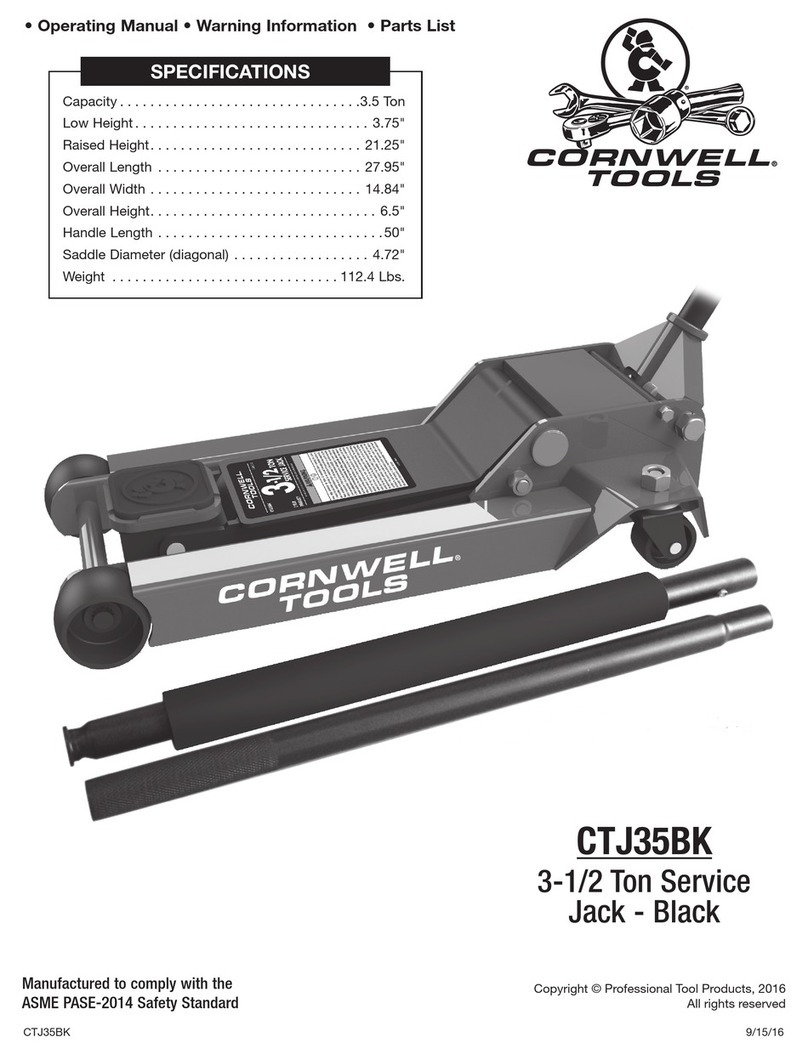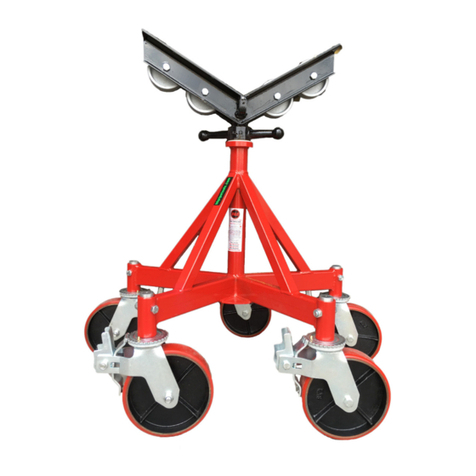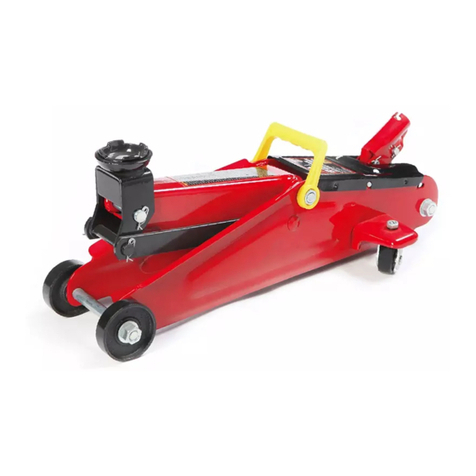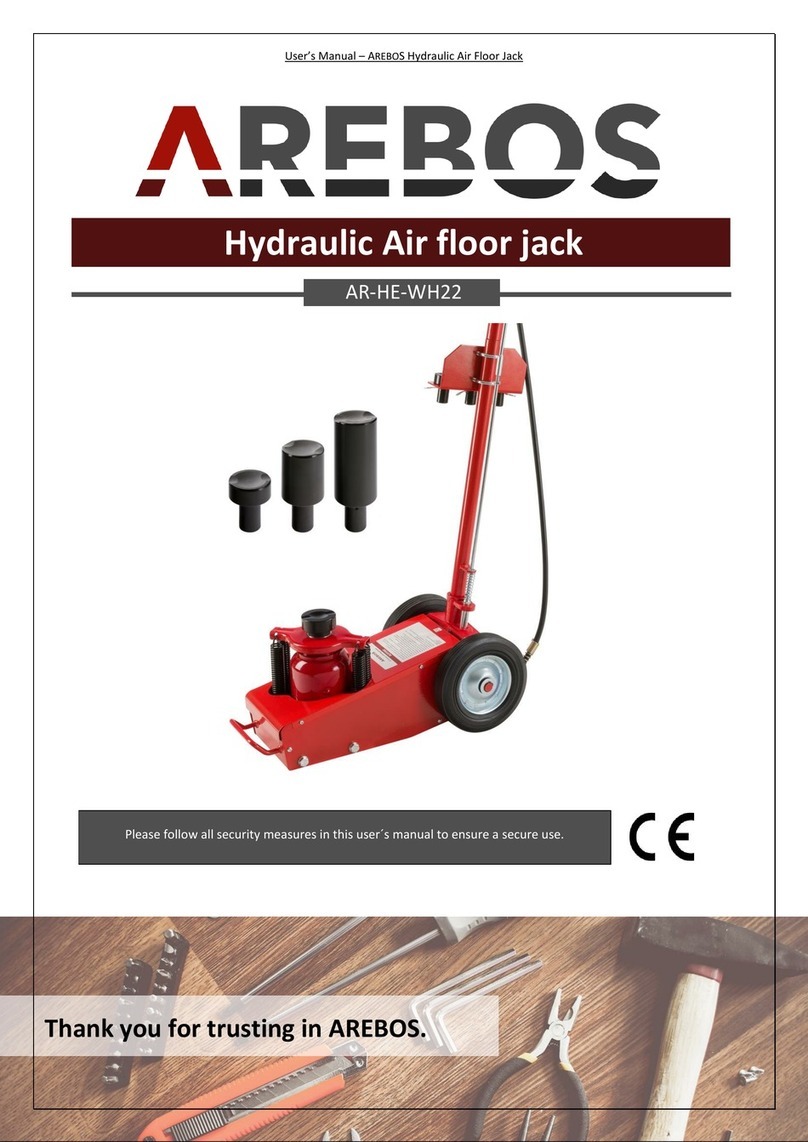BDS 2897 User manual

BGS technic KG
Bandwirkerstr. 3
42929 Wermelskirchen
Tel.: 02196 720480
Fax.: 02196 7204820
mail@bgs-technic.de
www.bgstechnic.com
© BGS technic KG, Vervielfältigung und Weiterverwendung verboten
Art. 2897
Hydraulischer Rangier-Wagenheber, 1,5 T.
SPEZIFIKATIONEN
Max. Hubkapazität: 1500 Kg
Min. Höhe: 90 mm
Hub: 268 mm
Länge: 554 mm
BESCHREIBUNG
Dieser Wagenheber ist zum Heben eines Teils des gesamten Fahrzeugs ausgelegt. Der Wagenheber
verfügt über ein Bypass-System für einen sicheren Betrieb und ein Überlastventil, die ein Ausfall des
Wagenhebers verhindert.
WARNUNG
Bevor Sie dieses Gerät in Betrieb nehmen, lesen Sie diese Bedienungsanleitung und befolgen Sie
alle Sicherheitsregeln und Betriebsanweisungen.
SICHERHEITSHINWEISE
Bedienungsanleitung lesen
Lesen, verstehen und befolgen Sie alle Anweisungen in dieser Bedienungsanleitung, bevor Sie den
Wagenheber in Betrieb nehmen. Die Nichtbeachtung dieser Warnungen kann zum Wegrutschen der
Last, Beschädigung oder Ausfall des Wagenhebers und zu Sachschäden oder Verletzungen führen.
Wagenheber Positionieren
Den Wagenheber nur an den vom Fahrzeughersteller angegebenen Punkten anheben.
Verwenden von Unterstellböcken
Nach dem Anheben das Fahrzeug immer mit entsprechend bemessenen Unterstellböcken sichern,
bevor an dem Fahrzeug gearbeitet wird.
Wagenheber nicht überlasten
Niemals eine Last anheben, die die Nennkapazität überschreitet.
Eine Überlastung des Wagenhebers über die Nennkapazität hinaus kann zu Beschädigung oder zum
Ausfall des Wagenhebers führen.
Anwendung auf festem Untergrund
Dieser Wagenheber ist nur für den Einsatz auf einem festen Untergrund geeignet, die die Last
aufnehmen kann.
Die Verwendung auf anderem Untergrund kann zu einer Instabilität des Wagenhebers und zum
Abrutschen der Last führen.
Wagenhebersattel mittig ausrichten
Vor dem Anheben des Fahrzeugs den Wagenheber zum Anhebepunkt ausrichten. Außermittig
angehobene Lasten, können zum Abrutschen der Last und Beschädigung des Wagenhebers führen.

BGS technic KG
Bandwirkerstr. 3
42929 Wermelskirchen
Tel.: 02196 720480
Fax.: 02196 7204820
mail@bgs-technic.de
www.bgstechnic.com
© BGS technic KG, Vervielfältigung und Weiterverwendung verboten
Halten Sie beim Absenken der Last die Hände und Füße von der Mechanik des Wagenhebers und
der Bodenkontaktfläche fern!
Dieser Wagenheber ist ausschließlich zum Anheben von Fahrzeugen geeignet
Dieser Wagenheber ist nur zum Anheben eines Teils des gesamten Fahrzeugs konzipiert.
Bewegen Sie das Fahrzeug nicht, solange es sich auf dem Wagenheber befindet.
GRIFFMONTAGE
•Entfernen Sie vor der Montage die an der Griffmuffe befestigte Klammer (Abb.1). Diese Klammer
ist nur für den Versand bestimmt und kein Bauteil des Wagenhebers.
•Drücken Sie den Federknopf am Griffstück "a" und stecken Sie das Griffstück "a" in das Griffstück
"b" (siehe Abb.2). Bitte achten Sie bei diesem Schritt auf Ihre Finger, es besteht Einklemmgefahr!
•Die in der Griffmuffe befindliche Schraube vollständig lösen und den zu montierenden Griff
einsetzen (Abb.3).
•Richten Sie die Bohrung (quadratisch) am unteren Ende des Griffs zu der Schraube im Griff aus.
•Sichern Sie den Griff, indem Sie die Schraube in der Griffmulde festziehen.
Abb.
1
Abb.
2
Abb.
3
Drücken
Griffstück
(b)
Griffstück
(a)
Federknopf
Griffstückunterteil
Schraube

BGS technic KG
Bandwirkerstr. 3
42929 Wermelskirchen
Tel.: 02196 720480
Fax.: 02196 7204820
mail@bgs-technic.de
www.bgstechnic.com
© BGS technic KG, Vervielfältigung und Weiterverwendung verboten
EXPLOSIONSZEICHNUNG UND TEILELISTE
Vorderer
Teil des Wagenhebers
Hinterer Teil des Wagenhebers
Hydraulikeinheit
1Vorderrad
2Sattel
3Hintere Lenkrolleneinheit
4Hydraulikeinheit
5Ablassventil
6Griffstückaufnahme
7Griff / Pumpenhebel
Griff
S
ch
raube
e
Pumpen
Kolben
Hinter
rad
Öleinfüllöffnung
Verschlusskappe
Sa
ttel
Hubarm
Tragegriff
Abb.7
Abb.6
Abb.5
Abb.4

BGS technic KG
Bandwirkerstr. 3
42929 Wermelskirchen
Tel.: 02196 720480
Fax.: 02196 7204820
mail@bgs-technic.de
www.bgstechnic.com
© BGS technic KG, Vervielfältigung und Weiterverwendung verboten
VERWENDUNG
Anheben
• Schließen Sie das Ablassventil, indem Sie den Griff im Uhrzeigersinn bis zum Anschlag drehen.
• Blockieren Sie die Räder des Fahrzeugs durch feststellen der Handbremse und Verwendung von
Unterlegkeilen.
• In der Betriebsanleitung des Fahrzeugherstellers finden Sie die am Fahrzeug zugelassenen
Lastaufnahmepunkte. Positionieren Sie den Wagenheber so, dass der Sattel zentriert unter dem
Lastaufnahmepunkt steht.
• Pumpen Sie mit dem Griffstück den Wagenheber auf Höhe des Lastaufnahmepunktes hoch.
Überprüfen Sie, dass der Sattel feste und zentriert am Lastaufnahmepunkt anliegt.
• Pumpen Sie mit dem Griffstück den Wagenheber auf gewünschte Höhe. Achtung: Bevor Arbeiten
am angehobenen Fahrzeug durchgeführt werden, ist die Last mit entsprechend bemessenen
Unterstellböcken abzustützen.
Absenken
Öffnen Sie das Ablassventil vorsichtig, indem Sie den Handgriff langsam gegen den Uhrzeigersinn
drehen.
Funktionsweise bei geschlossenem Ablassventil
•Eine Aufwärtsbewegung des Griffhebels bewirkt, dass das Öl aus dem Vorratsbehälter in den
Hydraulikzylinder gelangt. Der Hydraulikdruck hält das Ventil geschlossen, wodurch das Öl im
Hydraulikzylinder gehalten wird.
•Durch Abwärtsbewegung des Griffhebels wird das Öl im Zylinder durch den Hydraulikkolben
herausgedrückt und der Sattel wird angehoben.
•Ist der maximal zulässige Druck erreicht, wird das Öl wieder in den Vorratsbehälter zurückgeleitet,
dies verhindert einen übermäßigen Kolbenhub und eine mögliche Beschädigung des
Wagenhebers.
FEHLERBEHEBUNG
Wagenheber
hebt keine
Last
Wagenheber
hält keine
Last
L
ässt sich
nicht
absenken
Schlechte
Hub-
leistung
Ursache
Lösung
x Ablassventil offen
Ventil im Uhrzeigersinn bis zum Anschlag
drehen
x x Luft im Hydrauliksystem
Hydraulik entlüften
(siehe nächstes Kapitel)
x x x Ölstand zu niedrig
Erforderliche Ölmenge nachfüllen
x Ölstand zu hoch
Ölstand absenken
Bewegliche Teile fetten
x x x Fehlfunktion der Hydraulik
Hydraulikeinheit erneuern
ENTLÜFTUNGSVERFAHREN
Während des Transports oder beim Ölnachfüllen kann Luft in das Hydrauliksystem gelangen, was zu
einer schlechten Hubleistung führt. In diesem Fall ist ein Entlüften der Hydraulik wie folgt erforderlich:
1. Das Ablassventil vollständig öffnen, dazu den Griff gegen den Uhrzeigersinn drehen.
2. Den Pumpenhebel (Griff) schnell und mehrmals hintereinander auf- und abwärts bewegen.
3. Das Ablassventil zum Schließen im Uhrzeigersinn drehen.
4. Pumpenhebel mehrmals hintereinander betätigen, bis der Hubarm die maximale Höhe erreicht.
5. Das Ablassventil gegen den Uhrzeigersinn drehen und komplett öffnen. Wagenheber in die
unterste Position bringen, bei Bedarf mit einem Fuß den Sattel herunterdrücken.
6. Das Ablassventil im Uhrzeigersinn in die geschlossene Position drehen und die Funktion des
Wagenhebers prüfen. Es kann notwendig sein, die obigen Schritte mehr als einmal durchzuführen,
so ist sichergestellt, dass vorhandene Luft vollständig aus dem System entfernt ist.

BGS technic KG
Bandwirkerstr. 3
42929 Wermelskirchen
Tel.: 02196 720480
Fax.: 02196 7204820
mail@bgs-technic.de
www.bgstechnic.com
© BGS technic KG, Vervielfältigung und Weiterverwendung verboten
INSTANDHALTUNG
Öl nachfüllen
• Stellen Sie den Wagenheber auf einen ebenen Untergrund und senken Sie den Sattel ab und
entfernen Sie die Verschlusskappe der Öleinfüllöffnung.
• Füllen Sie Öl bis unterhalb der Öleinfüllöffnung nach.
• Entlüften Sie das System wie oben im Kapitel „Entlüftungsverfahren“ beschrieben.
Öl wechseln
• Öffnen Sie das Ablassventil vollständig, dazu den Handgriff, bis zum Anschlag, gegen den
Uhrzeigersinn drehen.
• Entfernen Sie die Verschlusskappe der Öleinfüllöffnung, drehen Sie den Wagenheber um und
lassen Sie das im System befindliche Öl aus der Öleinfüllöffnung ablaufen.
• Füllen Sie neues Öl bis unterhalb der Öleinfüllöffnung ein. Stellen Sie sicher, dass kein Schmutz
oder anderes Material beim Einfüllen ins System gelangt. Öleinfüllöffnung mit Verschlusskappe
verschließen.
• Entlüften Sie das System wie oben im Kapitel „Entlüftungsverfahren“ beschrieben.
Schmierung
• Schmieren Sie bei Bedarf alle beweglichen Teile mit Schmieröl wie z.B. WD40.
• Bei wenigem Gebrauch sind bewegliche Teile alle sechs Monate zu schmieren.
• Bei regelmäßigem Gebrauch in kurzen Abständen ist eine monatliche Schmierung empfohlen.
Rostschutz
•Prüfen Sie den Pumpenkolben der Hydraulikeinheit alle zwei Monate, je nach Gebrauch früher, auf
Anzeichen von Rost oder Korrosion (siehe Abb.5).
•Wenn Anzeichen von Rost sichtbar sind, reinigen Sie nach Bedarf und wischen Sie mit einem
ölhaltigen Tuch oder z.B. WD-40.
•Bringen Sie den Sattel in unterste Position, wenn Sie den Wagenheber lagern möchten.
Verwenden Sie immer eine gute Hydrauliköl-Qualität. Verwenden Sie keine Bremsflüssigkeit, Alkohol,
Glycerin, Reinigungsmittel, Motoröl oder Altöl. Die Verwendung einer nicht empfohlenen Flüssigkeit
kann den Wagenheber beschädigen.
.

BGS technic KG
Bandwirkerstr. 3
D-42929 Wermelskirchen
Tel.: 02196 720480
Fax.: 02196 7204820
mail@bgs-technic.de
www.bgstechnic.com
© BGS technic KG, Copying and further use not allowed
Art. 2897
Trolley Jack, 1.5 to.
SPECIFICATIONS
Max. Capacity: 1500 kgs
Min. Height: 90 mm
Stroke: 268 mm
Length: 554 mm
DESCRIPTION
This jack is designed for lifting a part of the total vehicle. The jack have a bypass system for safe
operation and overload valve, which prevent equipment failure.
WARNING:
Before using this appliance, read this Operator's Manual and follow all its Safety Rules and Operating
Instructions.
SAFETY INSTRUCTIONS
Read Operating Instructions
Study, understand and follow all instructions in this manual before operating the jack. Failure to heed
these warnings may result in loss of load, damage to the jack and/or jack failure resulting in personal
injury or property damage.
Position the Jack
Position the jack only to lift on the areas of the vehicle specified by the vehicle manufacturer.
Use Support Stands
After lifting the vehicle always support the load with appropriately rated vehicle supports stands before
working on the vehicle.
Do Not Overload Jack
Do not overload this jack beyond its rated capacity.
Overloading this jack beyond its rated capacity can cause damage to or failure of the jack.
Use on Hard Level Surface
This jack is designed only for use on hard level surfaces capable of sustaining the load. Use on other
than hard level surfaces can result in jack instability and possible loss of load.
Center Load on Jack Saddle
Center load on jack saddle before lifting vehicle. Off-center loads and loads lifted when the jack is not
level can cause loss of load or damage to the jack.

BGS technic KG
Bandwirkerstr. 3
D-42929 Wermelskirchen
Tel.: 02196 720480
Fax.: 02196 7204820
mail@bgs-technic.de
www.bgstechnic.com
© BGS technic KG, Copying and further use not allowed
Keep hands and feet clear of the jack hinge mechanism and ground contact area when lowering the
load!
THIS JACK IS A LIFTING DEVISE ONLY
This Jack is designed only for lifting parts of the total vehicle.
Do not move or dolly the vehicle while it is on the jack.
HANDLE ASSEMBLY
•Prior to assembly please remove the clip attached to the handle socket (picture 1). This piece it's
there for shipping purposes only and is not part of the jack.
•Refer to picture 2 when performing this step. Push in the Spring Button located on handle piece "a"
and insert handle "a" into handle "b". Please watch your fingers while performing this step, being
careful not to get pinched.
•Fully unfasten the screw located in the Handle Socket to insert the assembled handle (picture 3).
•Line up the square hole located at the bottom of the handle over the square bolt inside the Handle
Socket.
•Secure the handle in place by tightening the screw in the Handle Socket.
Pic.
1
Pic.
2
Pic.
3
Press
Handle (b)
Handle (a)
Spring Button
Handle Bottom
Screw

BGS technic KG
Bandwirkerstr. 3
D-42929 Wermelskirchen
Tel.: 02196 720480
Fax.: 02196 7204820
mail@bgs-technic.de
www.bgstechnic.com
© BGS technic KG, Copying and further use not allowed
EXPLODED VIEW AND PARTS LIST
Front of the jack
Back of the jack
Hydraulic Unit
1Front wheels
2Saddle
3Rear casters assembly
4Power unit assembly
5Release valve
6Handle socket
7Handle assembly
Handle
Screw
Pump
Piston
Rear
Wheels
Oil Fill Plug
Saddle
Lifting
Arm
Handle
Pic
.7
Pic.6
Pic
.5
Pic
.4

BGS technic KG
Bandwirkerstr. 3
D-42929 Wermelskirchen
Tel.: 02196 720480
Fax.: 02196 7204820
mail@bgs-technic.de
www.bgstechnic.com
© BGS technic KG, Copying and further use not allowed
OPERATION
Raising the Jack
• Close the release valve by turning the handle clockwise as far as it will go.
• Block the vehicle's wheels for lifting stability.
• Refer to the vehicle manufacturer owner's manual to locate approved lifting points on the vehicle.
Position the jack so that the saddle is centered and will contact the load lifting point firmly.
• Pump jack handle until saddle nears contact with the vehicle. Check to see that the saddle is
centered and will contact the load lifting point firmly.
• Continue to pump the jack handle to lift the vehicle to the desired height. After lifting, support the
load with appropriately rated vehicle support stands before working on the vehicle.
Lowering the Jack
• Carefully open the release valve by slowly turning the handle counterclockwise.
How it works with closed release valve
• An upward stroke of the jack handle draws oil from the reservoir tank into the plunger cavity.
Hydraulic pressure holds the valve closed, which keeps the oil in the plunger cavity.
• A downward stroke of the jack handle releases oil into the cylinder, which forces the ram out. This
raises the saddle.
• When the ram reaches maximum extension, oil is bypassed back into the reservoir to prevent an
over extended ram stroke and possible damage to the jack.
TROUBLESHOOTING
Jack will not
lift load
Jack will not
hold load
Jack will not
lower
Poor jack
lifting
Causes and
solutions
x Release valve is not completely
Turn clockwise
x x Air is in hydraulics
Purge air from system
x x x Low oil Level
Add oil as required
x
Oil reservoir is overfilled;
Drain excessive oil
Lubricate moving parts
x x x Power unit malfunctioning
Replace the power unit
AIR PURGE PROCEDURE
During shipment or after oil refill, air may get into the hydraulic system causing poor lifting
performance. Then system air purge is required as follows:
1. Turn the release valve fully counterclockwise to fully open the release valve.
2. Pump handle rapidly several times.
3. Turn the release valve clockwise to close the release valve.
4. Pump handle until the lift arm reaches maximum height and continue to pump several times to
remove trapped air in the ram.
5. Turn the release valve fully counterclockwise to lower lift arm to lowest position. Use force on
saddle if necessary.
6. Turn the release valve clockwise to closed position and check for proper pump action. It may be
necessary to perform the above steps more than once to assure air is evacuated totally.

BGS technic KG
Bandwirkerstr. 3
D-42929 Wermelskirchen
Tel.: 02196 720480
Fax.: 02196 7204820
mail@bgs-technic.de
www.bgstechnic.com
© BGS technic KG, Copying and further use not allowed
MAINTENANCE
To Add Oil
• Position the jack on level ground and lower the saddle. Remove the Breathing Screw.
• Fill the oil case until oil level is just beneath the lower rim of oil fill hole. Replace Breathing Screw.
• Perform the Air Purge Procedure described below.
To Replace Oil
• Fully open release valve by turning handle counterclockwise as far as it will go.
• Turn the jack over so that old oil will drain from the oil fill hole.
• Refill through oil fill hole. Keep dirt and other material clear when pouring. Fill to just beneath lower
rim of hole. Replace Breathing Screw.
• Perform Air Purge Procedure described below.
Lubrication
• Add lubricating oil (WD-40) to all moving parts when needed.
• For light duty use lubricate every six months.
• For heavy and constant use lubrication recommended every month.
Rust Prevention
• Check ram and pump plunger on the Power Unit Assembly every two months (or sooner, based on
usage) for any signs of rust or corrosion. Lift the jack as high as it goes and look under and behind
the lifting arm.
If signs of rust are visible clean as needed and wipe down with an oily cloth or e.g. WD-40.
• When storing the jack, always have the saddle and pump plunger in the down position.
Always use a good grade hydraulic jack oil. Do not use hydraulic brake fluid, alcohol, glycerine,
detergent, motor oil or dirty oil. Use of an un-recommended fluid can cause damage to your jack.

SW-Stahl und Werkzeugvertriebs GmbH Tel. +49 (0) 2191 / 46438-0
F5 6 e s s a r t S r e s u k r e v e Lax +49 (0) 2191 / 46438-40
e d . l h a t s w s @ o f n i : l i a M - Ed i e h c s m e R 7 9 8 2 4 - D
Manual de Instrucciones
BGS technic KG
Bandwirkerstr. 3
D-42929 Wermelskirchen
Tel.: 02196 720480
Fax.: 02196 7204820
www.bgstechnic.com
© BGS technic KG, Copying and further use not allowed
Art. 2897
Gato de carretilla, 1,5 T.
ESPECIFICACIONES
Capacidad maxima: 1500 Kg
Min. Altura: 90 mm
Carrera: 268 mm
Longitud: 554 mm
DESCRIPCION
El modelo BGS 2897 cuenta con una capacidad maxima de carga de 3,000 libras. La capacidad de
levantamiento para este gato va de 9 cm a 35.8 cm. El gato cuenta con una valvula de sobrocarga la
cual ayuda a prevenir fallas en el equpo. El sistema de derivacion contribuye a la seguridad del
funcionamiento.
ADVERTENCIA
Antes de utilizar este equipo, lea este manual y todas las normas de seguridad e instrucciones de
funcionamiento.
INSTRUCCIONES DE SEGURIDAD
Lea las Instrucciones de Operacion
Estudie, entienda y siga todas las instrucciones en este manual antes de operar el gato. No hacer
caso a estas indicaciones y advertencias podria resultar en la perdida de la carga, dano al gato y/o
mal funcionamiento de este resultando en dano personal o de propiedad.
La Posicion del Gato
Ponga el gato solamente en areas de levantamiento especificadas por el fabricante de su vehiculo.
Use Gatos de Soporte
Despues de levantar el vehiculo es importante que siempre soporte la carga con sopportes
apropiados relacionados e indicados antes de empezar a trabajar en el vehiculo.
No Sobrecargue el Gato
No sobrecargue este gato mas hay de su capacidad mecionada. La sobrecarga a este gato
rebazando su capacidad dpuede resultar en dano o mal funcionamiento del producto.
Usese en Superficies Duras y Firmes
Este gato esta disenado para uso solamente en superficies duras y firmes capaces de sostener la
carga. El uso en cualquier otro tipo de superficies que no sean especificadas anteriormente puede
danar el gato y causar inestabilidad y posible perdida de carga.
Centre la Carga en la Plataforma
Centre la carga en la plataforma del gato antes de levantar el vehiculo. Las cargas que no sean
centradas y cargas que sean levantadas cuando el gato no este nivelado puede causar perdida de la
carga o dano al gato y/o su vehiculo.

SW-Stahl und Werkzeugvertriebs GmbH Tel. +49 (0) 2191 / 46438-0
F5 6 e s s a r t S r e s u k r e v e Lax +49 (0) 2191 / 46438-40
e d . l h a t s w s @ o f n i : l i a M - Ed i e h c s m e R 7 9 8 2 4 - D
Manual de Instrucciones
BGS technic KG
Bandwirkerstr. 3
D-42929 Wermelskirchen
Tel.: 02196 720480
Fax.: 02196 7204820
www.bgstechnic.com
© BGS technic KG, Copying and further use not allowed
CONSERVE MANOS Y PIES FUERA DE LA MAQUINARIA DEL GATO Y CHEQUE EL AREA DE
CONTACTO CON EL PISO AL BAJAR LA CARGA!
ESTE GATO ES SOLO PARA LEVANTAR!
ESTE GATO ESTA DISENADO PARA LEVATAR SOLO PARTE DE TODO EL VEHICULO. NO
MUEVA O TAMBALEE EL VEHICULO MIENTRAS ESTE ENCIMA DEL GATO.
ENSAMBLAJE
Como ensamblar el mango
•Antes de empezar el ensamblaje, asegurese de retirar el clip que esta sosteniento el receptaculo
del mango (foto 1). Esta pieza se encuentra ahi por razones de paqueteria y no es parte del gato.
•Vea la fotografia 2 para este paso. Empuje en el boton de la pieza del mango "a" e insertela en la
pieza del mango "b". Tenga cuidado de no machucarse mientras esta haciendo esto.
•Desatore completamente el tornillo que se encuentra en el enchufe para la manija para colocar la
manija ensamblada anteriormente (foto 3).
•Alinee el orificio de forma cuadrada que esta en la parte baja de la manija con el tornillo de la
misma forma que se encuentra en el enchufe.
•Asegure la manija, aprentando muy bien el tornillo.
F
oto
1
Foto
2
Foto
3
prensa
M
ango
(b)
Mango
(a)
Boton
P
arte de Abaj
o
Tornillo

SW-Stahl und Werkzeugvertriebs GmbH Tel. +49 (0) 2191 / 46438-0
F5 6 e s s a r t S r e s u k r e v e Lax +49 (0) 2191 / 46438-40
e d . l h a t s w s @ o f n i : l i a M - Ed i e h c s m e R 7 9 8 2 4 - D
Manual de Instrucciones
BGS technic KG
Bandwirkerstr. 3
D-42929 Wermelskirchen
Tel.: 02196 720480
Fax.: 02196 7204820
www.bgstechnic.com
© BGS technic KG, Copying and further use not allowed
VISTA DETALLADA Y LISTA DE PIEZAS
F
RENTE DEL GATO
PARTE TRASERA DEL GATO
UNIDAD DE PODER
1Rueda dejantera
2Silla
3Ensamblaje de las traserasv
4Ensamblaje de la unidad hidráulica
5Valvuala de liberacion
6Agujero para es manejar
7Ensamblaje del manejar
Menejar
Tornillo
e
Piston
Ruedas
Traseras
tapon de Ilenado
de aceite
Plata
forma
Brazo
Levantador
Manija
Foto
7
Foto
6
F
oto
5
F
oto
4

SW-Stahl und Werkzeugvertriebs GmbH Tel. +49 (0) 2191 / 46438-0
F5 6 e s s a r t S r e s u k r e v e Lax +49 (0) 2191 / 46438-40
e d . l h a t s w s @ o f n i : l i a M - Ed i e h c s m e R 7 9 8 2 4 - D
Manual de Instrucciones
BGS technic KG
Bandwirkerstr. 3
D-42929 Wermelskirchen
Tel.: 02196 720480
Fax.: 02196 7204820
www.bgstechnic.com
© BGS technic KG, Copying and further use not allowed
OPERACION
Levantamiento del Gato
• Sierre la valvula de liberacion girando el mango hacia la derecha.
• Bloquee las ruedas del vehiculo para tener estabilidad al levantar.
• Consulte el manual del propietario del fabricante del vehiculo para localizar los puntos de
leventamiento aprobados en el vehiculo. Coloque el gato de tal modo que la montura quede
centrada y toque el punto de levantamiento de carga firmemente.
• Bombee el mango del gato hasta que la montura casi toque el vehiculo. Revise si la montura esta
centrada para que toque el pnto de levantamiento de la carga firmemente.
• Continue bombeando el mango del gato para levantar el vehiculo a la altura deseada. Despues de
levantar, soporte la carga con los puntales de apoyo clasificados adecuadamente para el vehiculo
antes de trabajar en el mismo.
Bajar el Gato
• Cuidadosamente abra la valvula de liberacion girando poco a poco la manija contra las manecillas
del reloj.
Como Funicona Con la Valvula de Liberacion Cerrada
•Si se acciona hacia arriba el mango del gato se extra aceite del tanque hacia la cavidad del
emobolo.
•La presion hidraulica mantiene la valvula cerrada, la cual mantiene el aceite en la cavidad del
embolo.
•Cuando el ariete alcance la extension maxima, el aceite se deriva nuevamente dentro del tanque
para evitar un movimiento extendido del ariete y posible dano al gato.
DETECCION Y SOULUCION DE FALLAS
El gato no
levanta la
carga
El gato no
sostiene la
carga
El gato
no baja
El gato
levanta
mal
Causas y soluciones
x
La valvula de liberacion no esta
completamente cerrada.
Girela hacia la derecha.
x x Hay aire en el sistema hidraulico.
Purgue el aire del Sistema.
x x x Nivel bajo de aceite.
Agregue el aceite que falte.
x
El tanque de aceite se
ha lienado es exceso.
Drene es exceso de aceite.
Lubrique las piezas.
x x x Fehlfunktion der Hydraulik
Hydraulikeinheit erneuern
PROCEDIMIENTO DE PURGA DE AIRE
El aire puede penetrar el sistema hidraulico durante el transporte o despued de llenar con aceite,
causando un rendimiento mas bajo. Esto requiere una purga de aire:
1. Para abrir completamente la valvula de escape girela completamente en sentido contrario a las
agujas del reloj.
2. Bombee rapidamente la manija varias veces.
3. Para cerrar la valvula de escape girela en sentido de las agujas del reloj.
4. Para eliminar el aire atrapado en el piston bombee la manija hasta que el brazo izador alcanze su
maxima y continue bombeando varias veces.
5. Gire la valvula de escape una vuelta completa en sentido contrario a las agujas del reloj y baje el
brazo izador a la posicion mas baja. Presione sobre la montura si fuera necesario.
6. Gire la valvula de escape a la derecha a la posicion cerrada y revise para asegurar que la accion
de la bomba es correcta. Para asegurarse que el aire ha sido completamente evacuado puede ser
necesario efectuar los pasos de arriba mas de una vez..

SW-Stahl und Werkzeugvertriebs GmbH Tel. +49 (0) 2191 / 46438-0
F5 6 e s s a r t S r e s u k r e v e Lax +49 (0) 2191 / 46438-40
e d . l h a t s w s @ o f n i : l i a M - Ed i e h c s m e R 7 9 8 2 4 - D
Manual de Instrucciones
BGS technic KG
Bandwirkerstr. 3
D-42929 Wermelskirchen
Tel.: 02196 720480
Fax.: 02196 7204820
www.bgstechnic.com
© BGS technic KG, Copying and further use not allowed
MANTENIMIENTO
Para Anadir Aceite
• Coloque el gato sobre suelo nivelado y baje la montura. Retire el tapon de aceite.
• Llene la caja de aceite hasta que quede nivelada con el agujero del taponde recarga de aceite.
• Realize la Purga de Aire descrito debajo.
Para Cambiar el Aceite
• Libere el conjunto de engranajes de la valvula y retire el tapon de recarga del aceite.
• Ponga boca abajo el gato para que el aceite usado escurra por el agujero de recarga.
• Llene atraves del agujero de recarga. Mantenga alejada la suciedad y otras materias al verter el
aceite.
• Realize la Purga de Aire descrito abajo.
• Bombee el mango del gato varias veces y sueltelo.
Lubricacion
• Anada aceite lubricate (WD-40) a todas las partes cada vez que sea necessario.
• Para uso ligero lubriquese cada 6 meses.
• Para uso pesado o constante se recomienda lubricarse cada mes.
Prevencion de la Corrosion
•Cheque por signos de oxhido o corrosion el embolo y partes alrededor en la Unidad de Poder de
Ensamblaje cada dos meses o cada vez que sea necesario dependiendo en el uso. Levante el
gato hasta donde llegue y mire debajo y atras del brazo de levantamiento. Si hay oxido simpie con
una toallacon aceite o use WD-40 todo alrededor.
•Cuando guarde el gato, siempre tenga la montura y el embolo de la bomba en la posion hacia
abajo.
SIEMPRE USE UN ACEITE PARA GATO HIDRAULlCO DE ALTA CALIDAD. NO USE LIQUIDO DE
FRENOS HIDRAULlCOS, ALCOHOL, GLICERINA, DETERGENTE, ACEITE DE MOTOR NI ACEITE
SUCIO. EL USO DE CUALQUIER LIQUIDO NO RECOMENDADO PUEDE DANAR EL GATO:
.

SW-Stahl und Werkzeugvertriebs GmbH Tel. +49 (0) 2191 / 46438-0
F56essartSresukreveL ax +49 (0) 2191 / 46438-40
ed.lhatsws@ofni:liaM-EdiehcsmeR79824-D
CE-Erklärung
BGS technic KG
Bandwirkerstr. 3
42929 Wermelskirchen
Tel.: 02196 720480
Fax.: 02196 7204820
www.bgstechnic.com
EU-KONFORMITÄTSERKLÄRUNG
EC DECLARATION OF CONFORMITY
DÉCLARATION„CE“ DECONFORMITE
DECLARATION DE CONFORMIDAD UE
Wir erklären in alleiniger Verantwortung, dass die Bauart des Produktes:
We declare that the following designated product:
Nous déclarons sous propre responsabilité que ce produit:
Declaramos bajo nuestra sola responsabilidad que este producto:
folgenden einschlägigen Bestimmungen entspricht:
complies with the requirements of the:
est en conformité avec les réglementations ci-dessous:
esta conforme a las normas:
Angewandte Normen:
Norme appliquée:
Normas aplicadas:
ppa.
Frank Schottke, Prokurist
BGS technic KG, Bandwirkerstrasse 3, D-42929 Wermelskirchen
Wermelskirchen, den
Hydraulischer Wagenheber, 1,5t. (BGS Art.: 2897)
Trolley Jack, 1,5 to.
Cric Rouleur
Gato de carretilla
Machinery Directive 2006/42/EC
EN 1494:2000 / A1:2008
Attestation of Conformity: M8A 15 03 23747 210 / T815016L
Certificate No.: Z1A 15 03 23747 202
Test Report No.: 70135408601-03
02.01.2017
Table of contents
Languages:
Popular Jack manuals by other brands
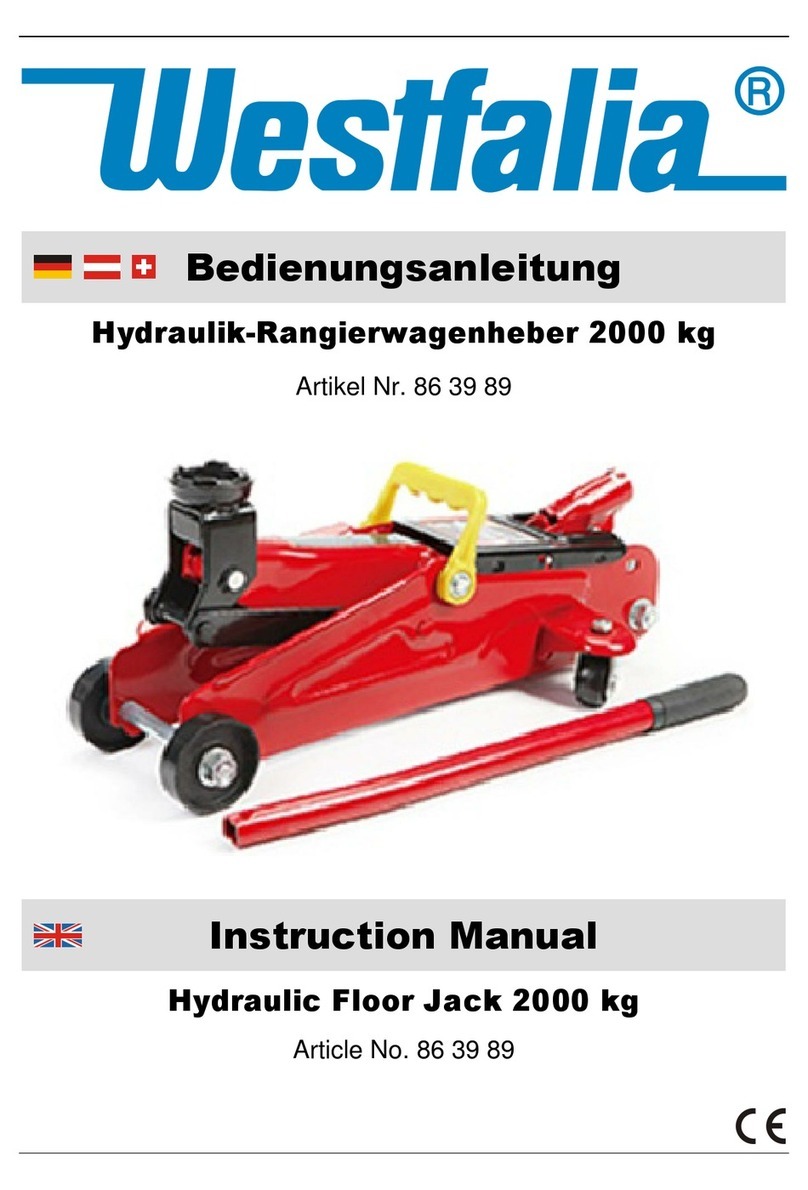
Westfalia
Westfalia 86 39 89 instruction manual
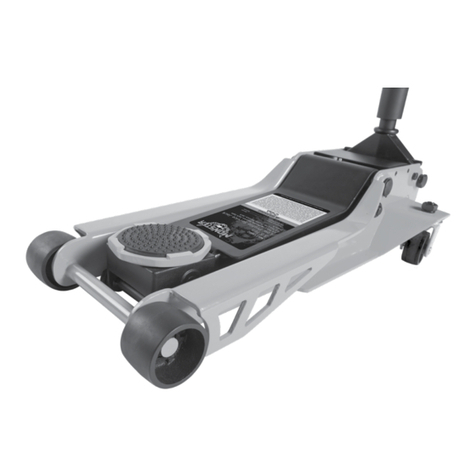
MONSTER MOBILE
MONSTER MOBILE MST13002 owner's manual
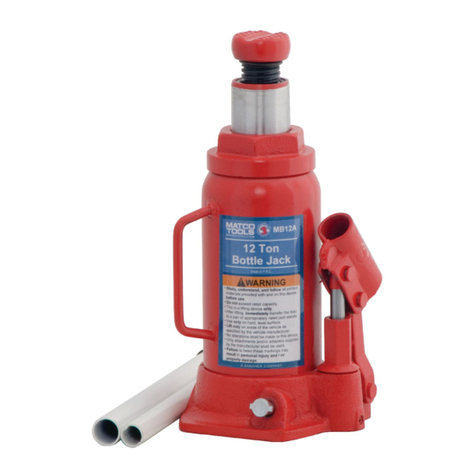
Matco Tools
Matco Tools MB12A Operating instructions & parts manual
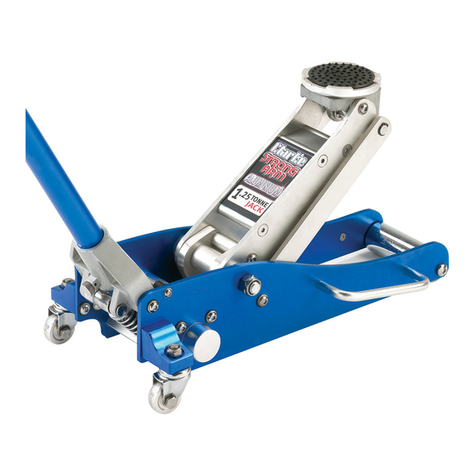
Clarke
Clarke STRONG-ARM CTJ1250A quick start guide

Pro-Lift
Pro-Lift F1800A owner's manual

HAUL MASTER
HAUL MASTER 69779 Owner's manual & safety instructions

Daytona
Daytona DS400SB Owner's manual & safety instructions

Hein-werner
Hein-werner AUTOMOTIVE HW93731 Operating instructions & parts manual
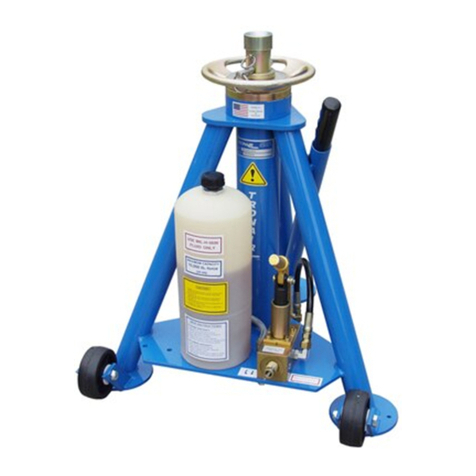
Tronair
Tronair 02-0536C0110 Operation & service manual
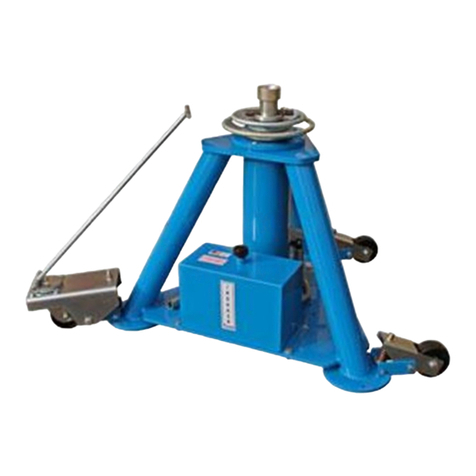
Tronair
Tronair 02-7815C0110 Operation & service manual
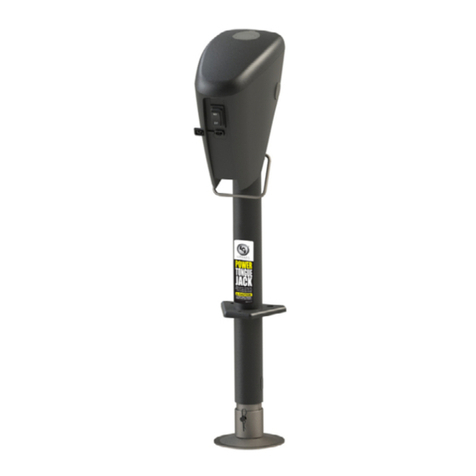
Lippert
Lippert PowerStance 813748 Installation and owner's manual
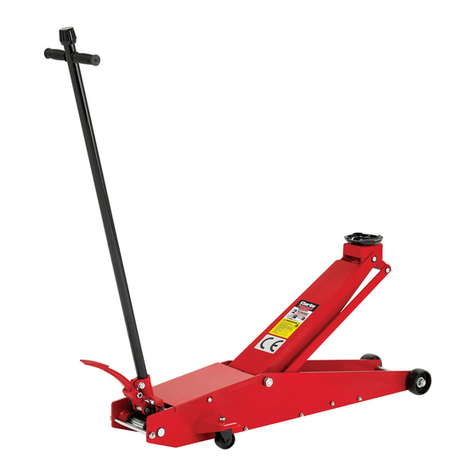
Clarke
Clarke Strong-Arm CTJ2GLS Operation & maintenance instructions
